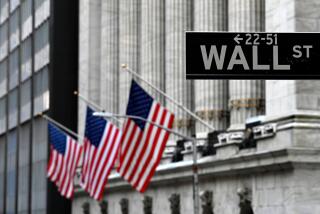ANNUAL MUTUAL FUND REVIEW & OUTLOOK : Stock Rocket : Investors Enjoy Gains for Third Consecutive Year
The stock mutual fund locomotive steamed ahead in 1993, as small investors in the typical stock fund enjoyed a third consecutive annual gain.
The average general U.S. stock fund rose 12.5% for the year, significantly better than the 8.9% average gain of 1992 and far above the 2.7% that investors might have earned if they sat out the often-volatile stock market in favor of a money market fund.
The average stock fund gain also was better than the 10.1% return (stock price appreciation plus dividends) in ’93 on the Standard & Poor’s 500 index, the benchmark of blue-chip stock performance.
For investors who diversified into foreign stock funds last year, the results were dramatically better: The average international fund rocketed 39.4% for the year, marking the first year since 1986 that foreign funds have outperformed U.S. stock funds.
The annual fund rankings, reported Tuesday by fund tracker Lipper Analytical Services in New York, will most likely gratify many of the small investors who channeled an unprecedented wave of cash into stock funds in 1993.
But investors also should realize that that cash wave helped create its own reward: As more money flowed into stock funds, fund managers pumped it into stocks, pushing the market up and thereby attracting new investors.
One measure of the market’s powerful and broad advance is that not a single category of stock funds lost ground last year; the worst-performing category, environmental funds (which own stocks of pollution-control companies), rose 3.4% for the year on average.
Whether the bullish cycle can repeat in 1994 is anyone’s guess, of course. In the fourth quarter, there were signs that fund managers themselves were growing wary of many high-flying growth stocks--in such fields as telecommunications and gaming--that had led the market earlier in the year.
As the funds stopped buying those stocks, many of the shares sank--which sparked a setback in the broader stock market in November. That, in turn, caused some small investors to turn skittish: Net new cash flows into stock funds fell 35% from October to November.
Nonetheless, many Wall Streeters believe the stock market and thus many stock funds have at least an even chance of advancing again in ‘94, if the economy continues to grow without a sharp rise in inflation or interest rates.
But even the most optimistic fund managers now warn that the market will be a much tougher game in 1994 and that a fund’s performance will depend almost entirely on a manager’s ability to pick the right stocks, rather than simply bet on riding the broad market higher.
Indeed, growth stock funds--the most-owned category of funds--may have provided in 1993 an early hint of what’s to come: The average growth stock fund gained 10.6% last year, the poorest performance (relatively speaking) of any major fund category.
Michael Lipper, head of Lipper Analytical, said the problem for the growth funds was that many of those fund managers were unwilling to part with consumer products stocks in such fields as drugs, food and tobacco, even as the stocks crumbled because of rising competition and loss of brand-name pricing power.
The 12.5% average stock fund return, meanwhile, was a product of the continuing strong performance of smaller stocks. The average small-company fund rose 17%, the third straight year in which small-stock funds beat more conservative blue-chip funds, such as equity-income funds.
Many Wall Streeters believe small stocks are in the middle of a five- to seven-year cycle of outperforming blue-chips, as the economy’s growth remains moderate--an environment that is believed to be tougher on bigger companies than on more nimble and opportunistic smaller ones.
Elsewhere, the surge in international stock markets, fed in large part by U.S. investors’ cash, is expected to continue in 1994, but not at the same torrid pace. And the potential for a temporary pullback in those streaking markets is extremely high, many analysts say.
In fact, the peasant rebellion in Mexico this week has provided novice international investors with their first taste of what can go wrong in thinly traded foreign markets. Mexican stocks plunged nearly 4% on Monday before rebounding somewhat Tuesday.
Still, many experts believe that international markets in general have better long-term prospects than the mature U.S. market. And given U.S. stocks’ three-year run, investors may have little choice in their pursuit of higher returns than to target foreign stocks and other market niches that have only recently begun to rally.
Hot Times for Gold, Foreign Funds ...
1993 average returns by stock mutural fund category:
Gold: +80.9% Pacific: +63.8% Latin American: +57.% International: +39.4% European: +26.0% Small-company: +16.9% Equity-income: +13.3% General stock fund avg.: +12.5% Growth: +10.6%
Average return on general stock funds: 1993: +12.5% Source: Lipper Analytical Services
Total stock mutual fund assets, end of each year since 1979 (except latest; end of November): in billions of dollars
1993: $659.3 Source: Investment Co. Institute
Investors Get More Aggressive
Since spring of 1992, the percentage of stock fund assets in the more conservative fund categories of growth and growth-and-income has slipped, while the asset share held by aggressive-growth and international funds has risen.
* APRIL, 1992
Growth & Income: 35.6% Growth: 28.7% Aggressive growth: 16.7% International-global: 10.0% Equity-income: 8.4% Gold: 0.6%
* NOVEMBER, 1993 Growth & Income: 33.1% Growth: 24.8% Aggressive growth: 17.9% International-global: 14.5% Equity-income: 9.0% Gold: 0.7%
More to Read
Inside the business of entertainment
The Wide Shot brings you news, analysis and insights on everything from streaming wars to production — and what it all means for the future.
You may occasionally receive promotional content from the Los Angeles Times.










